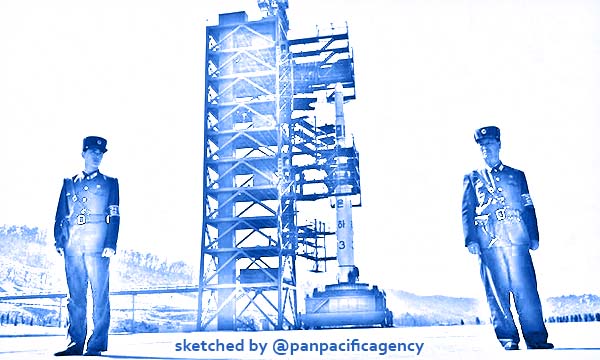[Analytics] North Korea satellite site test sends warning for 2020

North Korean soldiers guard the Unha-3 rocket at the Sohae Satellite Launch Station in Tongchang-Ri in 2012. Photo: AFP. Sketched by the Pan Pacific Agency.
North Korea announced Sunday that it had conducted a “very important test” at its satellite launch site, as its year-end deadline for the expiry of negotiations with the United States fast approaches.
Pyongyang did not reveal the nature of the test, nor have Seoul or Tokyo monitored any launches. However, the timing appears critical. Andrew Salmon specially for the Asia Times.
In April, North Korea announced that if talks with the US do not bear fruit by year’s end, it would seek a “new way” forward. And Sunday’s test came just days after experts in South Korea warned that North Korea may embark upon a new program of satellite launches and submarine-launched ballistic missile tests in 2020.
Why satellites?
The nature of the test was left vague.
“A very important test took place at the Sohae Satellite Launching Ground on the afternoon of December 7, 2019,” Pyongyang said in a statement carried by the Korean Central News Agency (KCNA) that was monitored by South Korea’s Yonhap news agency.
Moreover, the Academy of National Defense Science reported the “result of the successful test” to the Workers’ Party, the KCNA said
Some media speculate it was an engine test for a satellite launch vehicle. Since 1998, North Korea has attempted five satellite launches, three of which failed to attain orbit, and two of which succeeded. The latter achievements are widely celebrated in North Korea, featuring in Mass Games and commemorative postage stamps.
Problematically for the United States, satellite launch vehicles are dual-use technologies that can also be used in intercontinental ballistic missiles. Indeed, a promising 2012 North Korea-US agreement on missile tests and related nuclear issues collapsed after North Korea launched a satellite.
While North Korea has this year test-fired a range of barrage of short-range ballistic missiles and multiple-launch rocket systems artillery rockets, drawing verbal condemnation from the UN Security Council, it has not test-launched any ICBMs. The last such test, in 2017, drew particularly harsh rhetoric and prompted fears of war with the United States.
Last week, officials at the Sejong Institute, a Seoul think tank, predicted to foreign reporters that North Korea will, next year, embark upon a new program of satellite launches and submarine-launched ballistic missile (SLBM) tests.
“North Korea has agreed to cease activities on nuclear weapons and ICBMs, so it is likely they will pursue other items – which are satellites,” said Cheong Seong-chang, director of the institute’s Center for North Korean Studies. He considered future ICBM “difficult” – referring to the heavy international condemnation that such tests have incurred, resulting in a heavy tranche of UNSC sanctions.
“SLBM tests did not provoke international sanctions and [North Korean] SLBM technology is not complete, so there will be more technical completion of SLBMs, and satellite launches,” Cheong said.
Satellites can be “a viable option” for Pyongyang as they are not likely to earn the approbation of China or Russia, Cheong said. With Washington fully engaged in a trade war with Beijing, China is unlikely to support US demands for further sanctions at the UN Security Council.
Meanwhile, SLBM tests have not – so far – drawn the ire of US President Donald Trump.
It is unknown what Trump’s stance will be toward future satellite tests. He has brushed off this year’s missile tests, which threaten Japan and South Korea, while noting that North Korea continues to refrain from nuclear and ICBM tests.
The Sohae (“West Coast”) site is in North Korea’s northwest, south of the border with China. It was partly dismantled after the first North Korea-US summit in 2018, but more recently, open-source satellite images have shown renewed activity at the site.
Why now?
Last week, North Korean announced that it would hold a Worker’s Party plenary by the end of the year. The fact that Sunday’s mysterious test was reported to the Party suggests it is one tactic in hand as North Korea prepares to embark upon its “new way” – its strategy for next year, if and when it ceases to engage with the United States.
North Korea’s last ICBM test took place in November 2017; experts assessed that the missile had the range to hit the continental US. Since that test – which came amid soaring tensions with the United States, marked by a very public war of words between Kim Jong Un and Donald Trump – North Korea refrained from further tests of either nuclear devices or ICBMs, instead embarking upon a diplomatic charm offensive.
That saw previously secluded state leader Kim Jong Un emerging and meeting, for the first time, with a range of global leaders: China’s Xi Jinping, South Korea’s Moon Jae-in, the United States’ Donald Trump and Russia’s Vladimir Putin.
However, after the high hopes of 2018 and the first-ever North Korea-US leaders’ summit in Singapore, denuclearization talks have stalled in 2019. Trump “walked” from a second leaders’ summit in Hanoi and Pyongyang officials walked out of working-level talks in Sweden in October.
As recently as Saturday, however, Trump was holding out hope that North Korea – one of his highest-profile foreign policy priorities – would continue to act with restraint.
“I’d be surprised if North Korea acted hostilely,” Trump told reporters at the White House. “He knows I have an election coming up. I don’t think he wants to interfere with that. But we’ll have to see.”
That may be a vain hope. This week, Trump and North Korean state media have reignited a war of words that had lain dormant since the end of 2017. And both sides have resurrected previously used, inflammatory vocabulary.
At the NATO summit in London, Trump used the term “rocket man” to refer to Kim; North Korean state media responded that Trump was “a dotard in his dotage.”